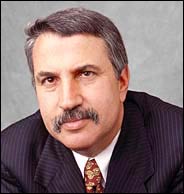Saturday, April 30, 2005

Fred R. Conrad/The New York Times
Thomas L. Friedman
April 29, 2005
OP-ED COLUMNIST
'What, Me Worry?'
By THOMAS L. FRIEDMAN
One of America's most important entrepreneurs recently gave a remarkable speech at a summit meeting of our nation's governors. Bill Gates minced no words. "American high schools are obsolete," he told the governors. "By obsolete, I don't just mean that our high schools are broken, flawed and underfunded. ... By obsolete, I mean that our high schools - even when they are working exactly as designed - cannot teach our kids what they need to know today.
"Training the work force of tomorrow with the high schools of today is like trying to teach kids about today's computers on a 50-year-old mainframe. ... Our high schools were designed 50 years ago to meet the needs of another age. Until we design them to meet the needs of the 21st century, we will keep limiting - even ruining - the lives of millions of Americans every year."
Let me translate Mr. Gates's words: "If we don't fix American education, I will not be able to hire your kids." I consider that, well, kind of important. Alas, the media squeezed a few mentions of it between breaks in the Michael Jackson trial. But neither Tom DeLay nor Bill Frist called a late-night session of Congress - or even a daytime one - to discuss what Mr. Gates was saying. They were too busy pandering to those Americans who don't even believe in evolution.
And the president stayed fixated on privatizing Social Security. It's no wonder that the second Bush term is shaping up as "The Great Waste of Time."
On foreign policy, President Bush has offered a big idea: the expansion of freedom, particularly in the Arab-Muslim world, where its absence was one of the forces propelling 9/11. That is a big, bold and compelling idea - worthy of a presidency and America's long-term interests.
But on the home front, this team has no big idea - certainly none that relates to the biggest challenge and opportunity facing us today: the flattening of the global economic playing field in a way that is allowing more people from more places to compete and collaborate with your kids and mine than ever before.
"For the first time in our history, we are going to face competition from low-wage, high-human-capital communities, embedded within India, China and Asia," President Lawrence Summers of Harvard told me. In order to thrive, "it will not be enough for us to just leave no child behind. We also have to make sure that many more young Americans can get as far ahead as their potential will take them. How we meet this challenge is what will define our nation's political economy for the next several decades."
Indeed, we can't rely on importing the talent we need anymore - not in a flat world where people can now innovate without having to emigrate. In Silicon Valley today, "B to B" and "B to C" stand for "back to Bangalore" and "back to China," which is where a lot of our foreign talent is moving.
Meeting this challenge requires a set of big ideas. If you want to grasp some of what is required, check out a smart new book by the strategists John Hagel III and John Seely Brown entitled "The Only Sustainable Edge." They argue that comparative advantage today is moving faster than ever from structural factors, like natural resources, to how quickly a country builds its distinctive talents for innovation and entrepreneurship - the only sustainable edge.
Economics is not like war. It can always be win-win. "But some win more than others," Mr. Hagel said, and today it will be those countries that are best and fastest at building, attracting and holding talent.
There is a real sense of urgency in India and China about "catching up" in talent-building. America, by contrast, has become rather complacent. "People go to Shanghai or Bangalore and they look around and say, 'They're still way behind us,' " Mr. Hagel said. "But it's not just about current capabilities. It's about the relative pace and trajectories of capability-building.
"You have to look at where Shanghai was just three years ago, see where it is today and then extrapolate forward. Compare the pace and trajectory of talent-building within their population and businesses and the pace and trajectory here."
India and China know they can't just depend on low wages, so they are racing us to the top, not the bottom. Producing a comprehensive U.S. response - encompassing immigration, intellectual property law and educational policy - to focus on developing our talent in a flat world is a big idea worthy of a presidency. But it would also require Mr. Bush to do something he has never done: ask Americans to do something hard.
Copyright 2005 The New York Times Company | Home | Privacy Policy | Search | Corrections | RSS | Help | Back to Top
